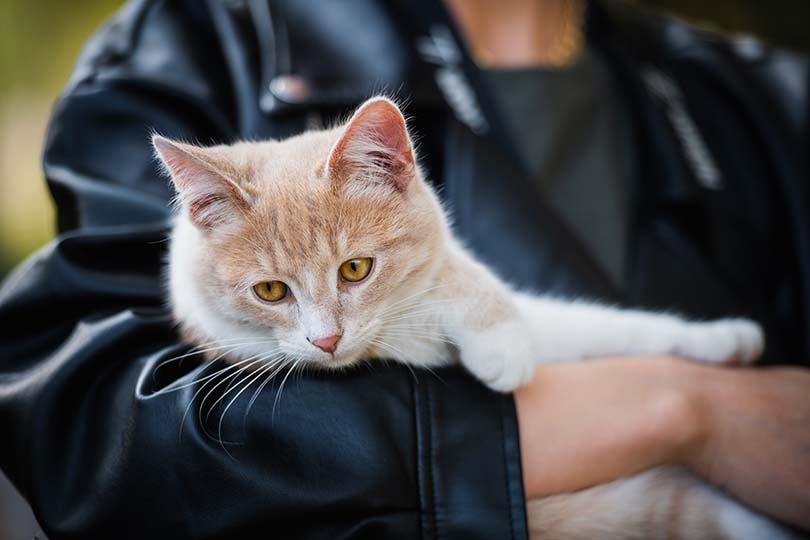VET APPROVED

The information is current and up-to-date in accordance with the latest veterinarian research.
Learn more »It’s one of those questions that has plagued mankind for eternity: How do you pick up a cat without getting scratched to shreds in the process?
As it turns out, there are ways to pick up a cat safely, but it’s not a foolproof guarantee that every cat will like it or tolerate it. These techniques will help keep you from hurting your cat, but they may not necessarily stop your cat from inadvertently hurting you. Most importantly, not all cats like to be picked up, and some may genuinely hate it and find it frightening, attempting to scratch in the process of trying to get away. Their preference should be respected. Most cats can be trained from an early age to tolerate being picked up.
For cats that don’t mind being picked up, or even enjoy it, all it takes is a little practice — and the proper know-how, of course. We can’t help you with the practice, but here, you should have all the information you need to make picking your cat up a painless operation for everyone involved.

Before We Begin — A Video Demonstration

It’s always helpful to have a visual reference for anything that you’re trying to do, and we feel that this video provides an excellent primer on how to pick up a cat properly.
It’s the same technique that veterinarians use when they have a friendly feline patient, and it’s designed to keep the cat safe while still enabling you to pick them up easily. It also lets you hold them securely without them wriggling as much, making it a good choice for when you need to trim their nails, brush their teeth, or do anything else that they might not appreciate, or even just give them a cuddle.
This is not the only way to pick up a cat, of course, but it’s one of the best ones that you’ll find.
Also, we should note that this technique is best used on your own cat or another domesticated cat who is used to being picked up and handled. You shouldn’t handle feral or unknown cats because they won’t have any reason to trust you and cat bites and scratches can be quite nasty. Leave handling those cats to the pros. Kittens should be picked up from a young age to learn to accept it and even enjoy it, making the process safer for both of you.
While this technique should minimize the danger that both you and your cat are in, it’s still a good idea to wear a long-sleeved shirt, but it’s up to you what you think that you’ll need — you know your cat best, after all.

The Underlying Theory Behind This Technique
The idea behind this technique is to keep your cat’s entire body comfortably supported at all times. If they feel like they’re on unstable ground or that you’re about to drop them, they’ll naturally try to prevent that from happening, and that means digging their claws into the nearest surface (i.e., you).
If your cat feels secure, they’ll be less likely to try and wriggle out. Of course, this isn’t the only thing that you need to do to keep everyone involved safe, as you’ll also need to secure their paws, but it’s a basic theory to have in mind with everything that you do while handling your feline friend.

The 3 Steps for Picking Up a Cat
1. Place Your Dominant Hand Underneath Them
With the cat facing away from you, slip your dominant hand under their stomach, then slide it and place it on their chest. Have a couple of your fingers in between their front legs, with the remaining fingers placed behind the opposite leg. Your thumb can loop around the front of that same leg if you need to keep their feet still. Otherwise, you can just support their chest from below and leave their paws to lean against your body.
This should allow you to comfortably support their upper body, while simultaneously giving you control over their front legs. You can also gently stroke their chest with your fingers while you do this, which can soothe and reassure them.

2. Put Your Other Hand Under Their Belly
With your dominant hand in place, take your other hand and bring it around the opposite side of the cat’s body, then place it under their belly. This should enable you to support the totality of their body weight while keeping that weight evenly spread.
This prevents you from putting too much pressure on any part of their body, which could lead to injury or discomfort for the cat, keeping their body in a neutral upright position. It also makes them feel secure, as there’s not any part of their body that’s dangling or that feels like it could fall to the ground.
3. Bring Them Toward Your Body
Lifting with both hands equally (so their entire body moves in one smooth, steady motion), bring the cat’s body close to yours. Use the elbow of your dominant hand to support the cat’s butt, all while pinning them gently but firmly against your chest.
You can then remove your non-dominant hand from their belly, so you’ll have a hand free to open doors, grab supplies, or do anything else that you need to do. The elbow will be doing all the work that that hand had been doing, so your cat shouldn’t feel like they’re unsupported or in danger at all.
You can also use your free hand to offer them treats or pet them, if they still feel nervous.
While your elbow is supporting their back half, you can still use the fingers on your dominant hand to control their front legs. This prevents them from scratching you or attempting to jump down. It also stops them from using their front legs to prevent you from shoving them into a carrier, making trips to the vet much easier for everyone involved.
Your grip throughout all of this should be firm but not overpowering. The cat should feel safe and secure, not like they’re being pinned down against their will. Using more force will be counterproductive, as it will likely just make the cat struggle and lash out even more than they otherwise would.


Putting Them Down Safely
If your cat’s not having a good time being picked up, putting them down can be the most dangerous part of the procedure, as it’s the point at which they’re free to seek their revenge.
To safely set them down, you’ll basically just do the reverse of the pick-up procedure. Take your free hand and place it back under their bellies, then (while controlling their legs) set them down with both hands doing an equal amount of work.
Be sure to place them down at arm’s length from your body. This will give them some distance from you, which should make them feel safer, while also allowing you to dodge any counterattacks that they may launch in your general direction.


You’re Now a Bona Fide Pickup Artist
This guide should give you all the information that you need to pick up your cat safely, without injuring either one of you in the process. For best results, though, you should pick your cat up like this all the time, starting from when they were a kitten; if you only use this technique when something unpleasant is about to happen (like a trip to the vet), your cat will quickly catch on that it means bad news, making things harder for everyone.
Use this technique to pick them up for love, treats, or to stare at that hummingbird outside the window. They’ll love it because it makes them feel safe, secure, and close to you (despite what they may tell you, they do actually love you), and you’ll love it because it enables you to bond with your cat without having to go to urgent care in the process.
See also: Biggest Cat Myths & Misconceptions: Get the Facts Straight
Featured Image Credit: Ann Kosolapova, Shutterstock











